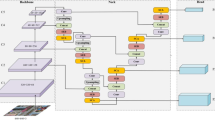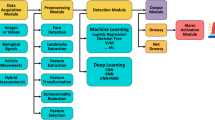Abstract
Intelligent Transportation Systems (ITS) are the most widely used systems for road traffic management. The vehicle type classification (VTC) is a crucial ITS task due to its capability to gather valuable traffic information. However, designing a performant VTC method is challenging due to the considerable intra-class variation of vehicles. This paper presents a new quantum decision-based method for VTC applied to video streaming. This method allows for earlier decision-making by considering a few stream’s images. Our method is threefold. First, the video stream is acquired and preprocessed following a specific pipeline. Second, we aim to detect and track vehicles. Therefore, we apply a deep learning-based model to detect vehicles, and then a vehicle tracking algorithm is used to track each detected vehicle. Third, we seek to classify the tracked vehicle according to six defined classes. Furthermore, we transform the tracked vehicles according to a pipeline, consisting of the histogram of oriented gradients (HOG), and principal component analysis (PCA) methods. Then, we estimate the vehicles’ probabilities of belonging to each class by training multilayer perceptron (MLP) classifier with the resulting features. To assign a class to a vehicle, we apply a quantum-inspired probability integrator that handles each frame’s information flow. The unique characteristics of the work we propose, compared to the existing ones, are expressed in the decision-making process, since the former requires a sequence of frames of different sizes, compared to the image-based-decision made by the other methods. Our method outperformed the baseline methods with an accuracy up to 96%.











Similar content being viewed by others
References
Awang S, Azmi NMAN (2018) Vehicle counting system based on vehicle type classification using deep learning method. In: IT Convergence and Security 2017, pp. 52–59. Springer
Cabri A (2020) Quantum inspired approach for early classification of time series. Ph.D. thesis, University of Genoa - Italy
Chong Y, Chen W, Li Z, Lam WHK (2011) Method for preceding vehicle type classification based on sparse representation. Trans Res Rec 2243(1):74–80. https://doi.org/10.3141/2243-09
Dalal N, Triggs B (2005) Histograms of oriented gradients for human detection. In: Computer Vision and Pattern Recognition, 2005. CVPR 2005. IEEE Computer Society Conference on, vol. 1, pp. 886–893. IEEE
Derrouz H, Elbouziady A, Abdelali HA, Thami ROH, Fkihi SE, Bourzeix F (2019) Moroccan video intelligent transport system: Vehicle type classification based on three-dimensional and two-dimensional features. IEEE Access 7:72528–72537. https://doi.org/10.1109/ACCESS.2019.2920740
Dong H, Wang X, Zhang C, He R, Jia L, Qin Y (2018) Improved robust vehicle detection and identification based on single magnetic sensor. IEEE Access 6:5247–5255. https://doi.org/10.1109/ACCESS.2018.2791446
Dong Z, Jia Y (2013) Vehicle type classification using distributions of structural and appearance-based features. In: 2013 IEEE International Conference on Image Processing, pp. 4321–4324. IEEE
Dong Z, Wu Y, Pei M, Jia Y (2015) Vehicle type classification using a semisupervised convolutional neural network. IEEE Trans Intell Trans Syst 16(4):2247–2256
Doran D, Gokhale SS (2016) An integrated method for real time and offline web robot detection. Expert Syst 33(6):592–606. https://doi.org/10.1111/exsy.12184
Gupte S, Masoud O, Martin R, Papanikolopoulos N (2002) Detection and classification of vehicles. IEEE Trans Intell Transp Syst 3(1):37–47
Hasnat A, Shvai N, Meicler A, Maarek P, Nakib A (2018) New vehicle classification method based on hybrid classifiers. In: 2018 25th IEEE International Conference on Image Processing (ICIP), pp. 3084–3088. https://doi.org/10.1109/ICIP.2018.8451642
Helstrom CW, Helstrom CW (1976) Quantum detection and estimation theory, vol. 3. Academic press, New York
Hernández G, Zamora E, Sossa H, Téllez G, Furlán F (2020) Hybrid neural networks for big data classification. Neurocomputing 390:327–340 https://doi.org/10.1016/j.neucom.2019.08.095. https://www.sciencedirect.com/science/article/pii/S0925231219314560
Hicham B, Ahmed A, Mohammed M (2018) Vehicle type classification using convolutional neural network. In: 2018 IEEE 5th International Congress on Information Science and Technology (CiSt), pp. 313–316. IEEE
Hsieh JW, Yu SH, Chen YS, Hu WF (2006) Automatic traffic surveillance system for vehicle tracking and classification. IEEE Trans Intell Trans Syst 7(2):175–187
Huang Y, Liu Z, Jiang M, Yu X, Ding X (2020) Cost-effective vehicle type recognition in surveillance images with deep active learning and web data. IEEE Trans Intell Transp Syst 21(1):79–86. https://doi.org/10.1109/TITS.2018.2888698
Ji P, Jin L, Li X (2007) Vision-based Vehicle Type Classification Using Partial Gabor Filter Bank. In: 2007 IEEE International Conference on Automation and Logistics, pp. 1037–1040. IEEE. https://doi.org/10.1109/ICAL.2007.4338720. http://ieeexplore.ieee.org/document/4338720/
Jiang M, Li H (2014) Vehicle Classification Based on Hierarchical Support Vector Machine. In: Z.T. Wong W.E. (ed.) Computer Engineering and Networking, vol. 277, pp. 593–600. Springer, Cham. https://doi.org/10.1007/978-3-319-01766-2_68
Kalman RE, Bucy RS (1961) New results in linear filtering and prediction theory. TRANS. ASME, SER. D, J. BASIC ENG p. 109
Lai AHS, Fung GSK, Yung NHC (2001) Vehicle type classification from visual-based dimension estimation. In: ITSC 2001. 2001 IEEE Intelligent Transportation Systems. Proceedings (Cat. No.01TH8585), pp. 201–206. https://doi.org/10.1109/ITSC.2001.948656
Ntalampiras S (2018) Moving vehicle classification using wireless acoustic sensor networks. IEEE Trans Emerg Top Comput Intell 2(2):129–138. https://doi.org/10.1109/TETCI.2017.2783340
Pareto V (2014) Manuel d’économie politique
Pedregosa F, Varoquaux G, Gramfort A, Michel V, Thirion B, Grisel O, Blondel M, Prettenhofer P, Weiss R, Dubourg V, Vanderplas J, Passos A, Cournapeau D, Brucher M, Perrot M, Duchesnay E (2011) Scikit-learn: machine learning in Python. J Mach Learn Res 12:2825–2830
Peng Y, Jin JS, Luo S, Xu M, Au S, Zhang Z, Cui Y (2013) Vehicle type classification using data mining techniques. In: The Era of Interactive Media, pp. 325–335. Springer
Peng Y, Jin JS, Luo S, Xu M, Cui Y (2012) Vehicle type classification using pca with self-clustering. In: Multimedia and Expo Workshops (ICMEW), 2012 IEEE International Conference on, pp. 384–389. IEEE
Petrovic V, Cootes T (2004) Analysis of features for rigid structure vehicle type recognition. British Machine Vision Conference 2:587–596. https://doi.org/10.5244/C.18.61. http://www.isbe.man.ac.uk/~bim/Papers/petrovic_bmvc04.pdf
Psyllos A, Anagnostopoulos C, Kayafas E (2011) Vehicle model recognition from frontal view image measurements. Computer Standards & Interfaces 33(2):142–151 https://doi.org/10.1016/j.csi.2010.06.005. https://linkinghub.elsevier.com/retrieve/pii/S0920548910000838
Redmon J, Divvala S, Girshick R, Farhadi A (2016) You only look once: Unified, real-time object detection. In: Proceedings of the IEEE conference on computer vision and pattern recognition (2016), pp. 779–788
Redmon J, Farhadi A (2018) Yolov3: An incremental improvement. arXiv preprint arXiv:1804.02767
Russakovsky O, Deng J, Su H, Krause J, Satheesh S, Ma S, Huang Z, Karpathy A, Khosla A, Bernstein M, Berg AC, Fei-Fei L (2015) ImageNet large scale visual recognition challenge. Int J Comp Vis (IJCV) 115(3):211–252. https://doi.org/10.1007/s11263-015-0816-y
Sekachev B, Manovich N, Zhiltsov M, Zhavoronkov A, Kalinin D, Hoff B, TOsmanov, Kruchinin D, Zankevich A, DmitriySidnev, Markelov M, Johannes222, Chenuet M, a andre, telenachos, Melnikov A, Kim J, Ilouz L, Glazov N, Priya4607, Tehrani R, Jeong S, Skubriev V, Yonekura S, vugia truong, zliang7, lizhming, Truong T (2020) opencv/cvat: v1.1.0. https://doi.org/10.5281/zenodo.4009388
Seo Y, Shin Ks (2018) Image classification for vehicle type dataset using state-of-the-art convolutional neural network architecture. In: Proceedings of the 2018 Artificial Intelligence and Cloud Computing Conference, pp. 139–144
Sergioli G, Giuntini R, Freytes H (2019) A new quantum approach to binary classification. PloS One 14(5):e0216224
Shan Y, Sawhney HS, Kumar R (2008) Unsupervised learning of discriminative edge measures for vehicle matching between nonoverlapping cameras. IEEE Trans Patt Anal Mach Intell 30(4):700–711
Shvai N, Meicler A, Hasnat A, Machover E, Maarek P, Loquet S, Nakib A (2018) Optimal ensemble classifiers based classification for automatic vehicle type recognition. In: 2018 IEEE Congress on Evolutionary Computation (CEC), pp. 1–8. https://doi.org/10.1109/CEC.2018.8477979
Song F, Guo Z, Mei D (2010) Feature selection using principal component analysis. In: 2010 international conference on system science, engineering design and manufacturing informatization, 1, 27–30. IEEE
Wang X, Zhang W, Wu X, Xiao L, Qian Y, Fang Z (2019) Real-time vehicle type classification with deep convolutional neural networks. J Real-Time Image Proc 16(1):5–14
Wang Y (2020) A mathematical introduction to generative adversarial nets (gan)
Weng SK, Kuo CM, Tu SK (2006) Video object tracking using adaptive kalman filter. J Visual Comm Image Repres 17(6):1190–1208
Wojke N, Bewley A, Paulus D (2017) Simple online and realtime tracking with a deep association metric. In: 2017 IEEE International Conference on Image Processing (ICIP), pp. 3645–3649. IEEE. https://doi.org/10.1109/ICIP.2017.8296962
Zhang C, Chen X, Chen Wb (2006) A pca-based vehicle classification framework. In: 22nd International Conference on Data Engineering Workshops (ICDEW’06), pp. 17–17. IEEE
Acknowledgments
This work was supported in part by the CNRST and in part by the MESRSFC, through the Development of an Integrated System for Traffic Management and Detection of Road Traffic Infractions Project.
Author information
Authors and Affiliations
Corresponding author
Ethics declarations
Conflicts of interest
We declare that we have no financial and personal relationships with other people or organizations that can inappropriately influence our work, and there is no professional or other personal interest of any nature or kind in any product, service and company that could be construed as influencing the position presented in, or the review of, the manuscript entitled, “End-to-end quantum inspired method for vehicle classification based on video stream”
Additional information
Publisher's Note
Springer Nature remains neutral with regard to jurisdictional claims in published maps and institutional affiliations.
Rights and permissions
About this article
Cite this article
Derrouz, H., Cabri, A., Ait Abdelali, H. et al. End-to-end quantum-inspired method for vehicle classification based on video stream. Neural Comput & Applic 34, 5561–5576 (2022). https://doi.org/10.1007/s00521-021-06718-9
Received:
Accepted:
Published:
Issue Date:
DOI: https://doi.org/10.1007/s00521-021-06718-9




